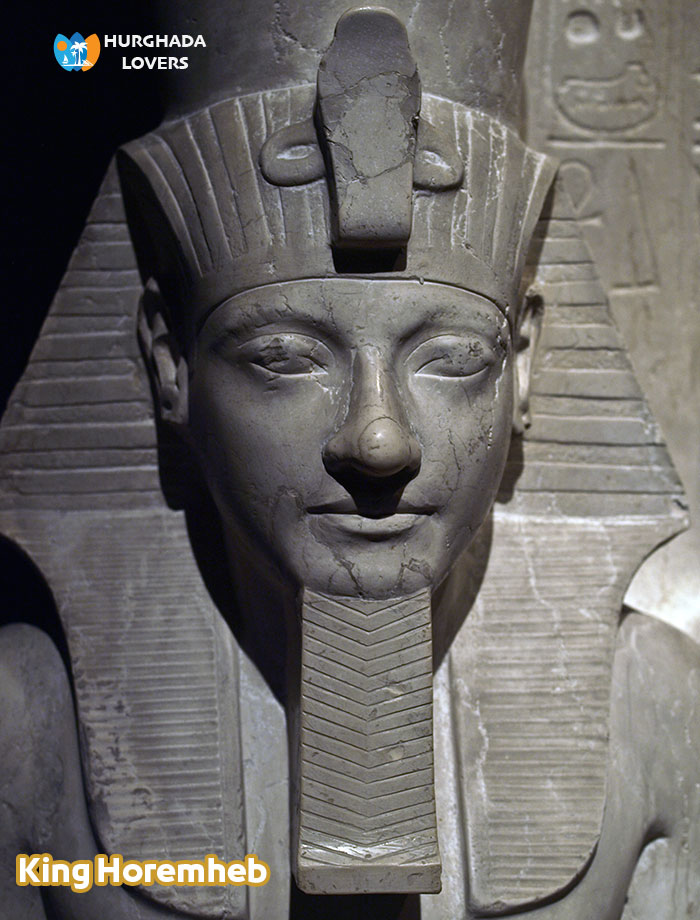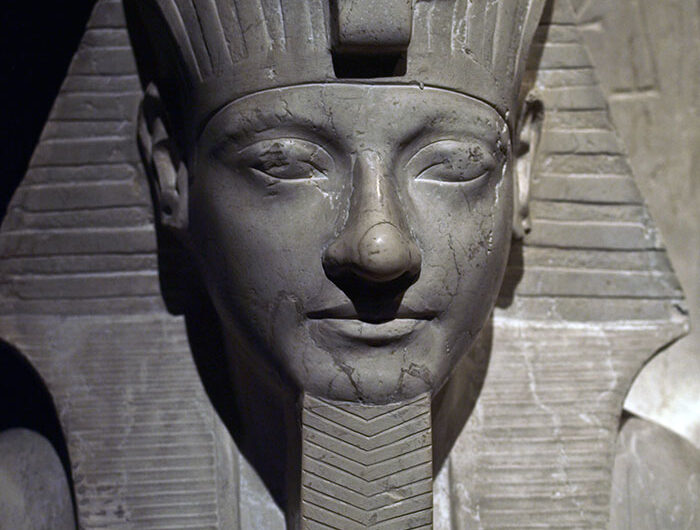King Horemheb – Egyptian Pharaohs kings – Eighteenth Dynasty of Egypt – The New Kingdom
“Horemhab or Haremhab” | Facts & History The Greatest of Egyptian Pharaohs kings | Secrets, Biography, Accomplishments in Ancient Egypt, Tomb, Mummy, Life and Death of the King, 18th Dynasty and more about Ancient Egypt History…
Ruling period: 1338–1308 BC
Duration of rule in Ancient Egyptian Government: 4 years.
Date of death: 1292 BC
Wife: Queen Amenia, the most famous Pharaonic queen of Egypt “Female Pharaohs“, Queen Mutnedjmet.
Archaeology:
- Stone statues indicating the development of Sculpture in Ancient Egypt and Architecture in ancient Egypt during the era of King Horemheb.
- Tomb of Horemheb | KV57 in Valley of the Kings Tombs “Egyptian Tombs” in Luxor.
- The Speos Of Horemheb in Aswan.
- Mount Ad Temple, near the area of Temple of Abu Simbel and Gebel el-Silsila in southern Egypt, are among the Egyptian Temples.
- Tomb of Horemheb – Saqqara.
King Horemheb Facts
- He is considered one of the most famous military commanders in the ancient Pharaonic civilization of Egypt “Military of ancient Egypt“, where he served as chief archer in the royal army and then became commander-in-chief of the armies during the reign of King Tutankhamun during the rule of the Eighteenth Dynasty of Egypt in the era of The New Kingdom in ancient Egypt.
- He built his own Tomb of Horemheb – Saqqara, but he was not buried there. He was buried in the royal Tomb of Horemheb | KV57 in the Valley of the Kings Tombs in Luxor, in addition to The Speos Of Horemheb in Aswan.
- He assumed the rule of the throne of Egypt after the death of king Ay “The Tomb of King Ayi | KV23 / WV23, Tomb of Ay – Ta 25 in Tombs of the Nobles Amarna – Tell el-Amarna – Al Minya” and became the new Pharaoh of Egypt after seizing the throne illegally and He received the Coronation of the Pharaohs.
- There are theories that confirm that he was the one who killed King Tut and quickly fled to his army on the border “Geography of ancient Egypt“, so that no one would notice his presence in the palace and that he was the reason for killing King Tutankhamun “Tomb of Tutankhamun | KV62″. The back with a knife in his head.
- He was the military leader in wars and battles to protect Egypt’s foreign lands against the Hittites and the Kingdom of Mitanni.
- King Horemheb ruled Egypt for 25 years.
- The Pharaonic king is considered the last king of the Eighteenth Pharaonic Dynasty.
- Despite the wide fame enjoyed by King Horemheb, there is not much around him.
- It is known that he was the last king of the eighteenth Egyptian family.
- Horemheb assumed a number of positions, including the royal foreign spokesman for Egypt.
- This function was known by seeing him next to the king in the chapel of Horemheb’s tomb, which is currently located in the Saqqara region.
- One of the jobs undertaken by King Horemheb was leading a group of diplomatic missions that used to visit the rulers of Nubia and To increase Trade in Ancient Egypt.
- Those missions affected the relationship between Egypt and Nubia positively, and therefore the Emir of Nubia came to visit King “Tutankhamun”.
- Because of that close relationship, which was caused by Horemheb, his importance and love for Horemheb increased with Tutankhamun, so he became the Pharaoh’s advisor and army commander.
Minister of Tutankhamun
- There is some evidence from Egyptology that King Horemheb was not the only minister to King Tutankhamun.
- There were two other ministers, including “Khabar Khebro Ra Ai” and the other is Horemheb.
- There is also evidence indicating that Vizier Ay assumed power for a period of time after the death of King Tutankhamun, after which King Horemheb took his place and focus on developing Ancient Egyptian science and Medicine in ancient Egypt.
- During his reign, something surprising happened among historians, which is the destruction of a very large group of evidence that talked about Tutankhamun and Minister A.
- Which shows that the death of Tutankhamun was the result of a conspiracy and assassination, contrary to what was said in the past that he died of a disease that afflicted him.
What is King Horemheb known for?
- Since the era of King Akhenaton and Queen Nefertiti, there has been a large group of symptoms and Revolutions in Ancient Egypt of chaos experienced by the country in that period.
- King Horemheb worked to solve it and curb the wrong use of power through the privileges that were made available to some.
- Where Horemheb reappointed the judges, in addition to restoring the legal authority department To enforce the Law in Ancient Egypt “Maat“, which linked the ministers of Thebes and from him.
- Horemheb was also able to restore the local religious authorities, give Power to High Priest of Amun and was able to restore the government administration and Restoration of funerary Mortuary Temples.
- The King put in place legislation and laws aimed at regulating the lives of Egyptians in general. He was also keen on setting laws that regulate the relationship between the people and the authority as in Social Structure in Ancient Egypt.
What did King Horemheb do for Egypt?
- King Hor Moheb carried out a series of construction works, including the Temple of Jabal Aad, which is located between Wadi Halfa and Abu Simbel “Egypt Archaeological Sites“.
- The king also built a hall for celebrations “Festivals in Ancient Egypt” in the Luxor Temple and came with 7 columns and a roof.
- The courtyard led from King Amenhotep III outer court to a very large courtyard.
- The walls of the temple contain a large group of distinctive inscriptions.
- Regarding the tomb of Horemheb, his initial intention was to build a non-royal tomb in the Saqqara area.
- But after he took the throne, he built a royal tomb in the Valley of the Kings.
- The tomb of King Horemheb was found in the same area as the tomb of King Tutankhamun.
- The tomb of King Horemheb came with a large group of inscriptions as well, but they were different from the traditional inscriptions “Ancient Egyptian Language“, due to the fact that the inscriptions were prominent.
- Tutankhamun was not the only one adjacent to the tomb of Horemheb, but also the Tomb of King Ramesses III | KV11 “King Ramses III of the Twentieth Egyptian Dynasty, known as The Ramesside Period”, the Tomb of King Ramses V + King Ramesses VI | KV9 “King Ramses V and King Ramses VI”. In addition to the Tomb of King Sethi I | KV17 from the Nineteenth Dynasty of Egypt, “King Seti I”
- King Horemheb chose Minister Ramses as his successor, and King Ramesses I “Tomb of King Ramesses I | KV16″ ruled Egypt for only two years.
- It is worth noting that Ramses I is the founder of the nineteenth dynasty, which follows the family of King Horemheb.
Facts and history of the greatest Egyptian warrior kings of the pharaohs | Secrets, biography, achievements in the civilization of ancient Egypt, tomb, mummy, life and death of the king, the eighteenth dynasty dynasty and more…
King Horemheb, one of the great kings of Egypt. He is the last member of the Eighteenth Dynasty. He ruled Egypt from 1338 to 1308 BC. His full name is “Hoor Moheb Meri Amun.” The name means Hor on the feast of the beloved God Amun “The most famous ancient Egyptian deities in Ancient Egyptian religion“.
The most important monuments left by King Horemheb before he became king
- A statue of “Horemheb” in the Temple of Amun in Karnak, now preserved in the Egyptian Museum.
- Horemheb created a luxurious tomb in Saqqara, reflecting the art of Amarna, and parts of it are in various museums around the world..
- Parts of his tomb are in museums such as the Leiden Museum, the Vienna Museum, the Bologna Museum, the British Museum, the Alexandria Museum, and the Leningrad Museum..
- Evidence was found indicating the presence of the name “Horemheb” in the inscriptions of the tomb of a high priest in Memphis, and on the eastern wall of the burial chamber of King Tutankhamun.”.
The effects of King Horemheb
- Horemheb founded a tomb for himself in the third year of his reign, and this tomb clearly shows the art of the Amarna period.
- There is no confirmed information about the dates of the wars that “Horemheb” fought, whether in Sudan or with the “Hayunbut” peoples in the north..
- Documents indicate that “Horeheb” ruled for a long time, and there is an astrakon dated to the seventh year of his reign, which refers to a complaint by a man called “Hai” regarding his father’s grave..
- Despite the abolition of the worship of Aten and the return of the worship of Amun, Horemheb restored some of the temples of Aten and used their stones to build new buildings. He also built gates in the Temple of Tutankhamun in Karnak..
King Horemheb effects after assuming the throne
- During the reign of Horemheb, Apis III and Apis IV were buried in a double tomb. This appears in the first and second chambers, where the walls were decorated with images of the gods and Apis himself..
- In the village of Busri, pieces were found bearing the Tughra of Horemheb, and in the Temple of Ptah in Memphis, a statue of him was found, which is now in the Metropolitan Museum in New York..
- In Ghurab, I found rings with his name on him, and in Cairo, I found a plaque and a sandstone door corner..
- In “Araba” near the Temple of “Seti I”, statues were found in his name along with “Osiris” and “Isis”.”.
- In “Thebes” in Karnak, he erected three gates that were found extending in front of them along a path of rams. He also built a wall of granite..
- He put his name on the pillars of Amenhotep III in the Luxor Temple, and his name was engraved on the western wall of the temple.
- He left us wonderful statues of white limestone, red basalt and black basalt.
- He also left us small traces such as rings, talismans, and scarabs.
- His wife also left her a statue with him, and she found rings.
Note: Facts and secrets of the history of the Pharaoh kings will be added soon…
Hurghada Excursions Lovers, Best Travel Agency in Hurghada to provide daily tours to visit the Tourist attractions of Luxor by Hurghada to Luxor Tours.

